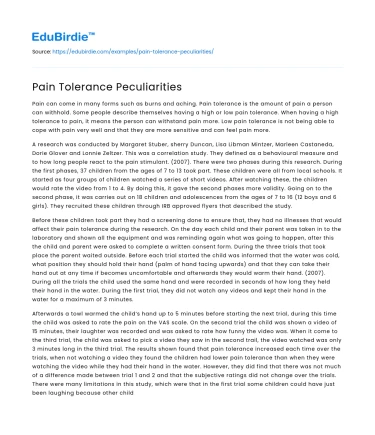Pain can come in many forms such as burns and aching. Pain tolerance is the amount of pain a person can withhold. Some people describe themselves having a high or low pain tolerance. When having a high tolerance to pain, it means the person can withstand pain more. Low pain tolerance is not being able to cope with pain very well and that they are more sensitive and can feel pain more.
A research was conducted by Margaret Stuber, sherry Duncan, Lisa Libman Mintzer, Marleen Castaneda, Dorie Glover and Lonnie Zeltzer. This was a correlation study. They defined as a behavioural measure and to how long people react to the pain stimulant. (2007). There were two phases during this research. During the first phases, 37 children from the ages of 7 to 13 took part. These children were all from local schools. It started as four groups of children watched a series of short videos. After watching these, the children would rate the video from 1 to 4. By doing this, it gave the second phases more validity. Going on to the second phase, it was carries out on 18 children and adolescences from the ages of 7 to 16 (12 boys and 6 girls). They recruited these children through IRB approved flyers that described the study.
Save your time!
We can take care of your essay
- Proper editing and formatting
- Free revision, title page, and bibliography
- Flexible prices and money-back guarantee
Before these children took part they had a screening done to ensure that, they had no illnesses that would affect their pain tolerance during the research. On the day each child and their parent was taken in to the laboratory and shown all the equipment and was reminding again what was going to happen, after this the child and parent were asked to complete a written consent form. During the three trials that took place the parent waited outside. Before each trial started the child was informed that the water was cold, what position they should hold their hand (palm of hand facing upwards) and that they can take their hand out at any time if becomes uncomfortable and afterwards they would warm their hand. (2007). During all the trials the child used the same hand and were recorded in seconds of how long they held their hand in the water. During the first trial, they did not watch any videos and kept their hand in the water for a maximum of 3 minutes.
Afterwards a towl warmed the child’s hand up to 5 minutes before starting the next trial, during this time the child was asked to rate the pain on the VAS scale. On the second trial the child was shown a video of 15 minutes, their laughter was recorded and was asked to rate how funny the video was. When it come to the third trial, the child was asked to pick a video they saw in the second trail, the video watched was only 3 minutes long in the third trial. The results shown found that pain tolerance increased each time over the trials, when not watching a video they found the children had lower pain tolerance than when they were watching the video while they had their hand in the water. However, they did find that there was not much of a difference made between trial 1 and 2 and that the subjective ratings did not change over the trials. There were many limitations in this study, which were that in the first trial some children could have just been laughing because other children were laughing. In the second phase, the children could have built up a tolerance for the cold water, which is why they had a higher tolerance. The sample size was very small due to it only being a piolet study this meant that there was not a big sample size for gender and that a lot of the children was from the same location which could affect the validity of the research and also they couldn’t guarantee that what the children was saying was valid.
Did you like this example?
Make sure you submit a unique essay
Our writers will provide you with an essay sample written from scratch: any topic, any deadline, any instructions.
Cite this paper
-
APA
-
MLA
-
Harvard
-
Vancouver
Pain Tolerance Peculiarities.
(2022, February 17). Edubirdie. Retrieved December 21, 2024, from https://edubirdie.com/examples/pain-tolerance-peculiarities/
“Pain Tolerance Peculiarities.” Edubirdie, 17 Feb. 2022, edubirdie.com/examples/pain-tolerance-peculiarities/
Pain Tolerance Peculiarities. [online].
Available at: <https://edubirdie.com/examples/pain-tolerance-peculiarities/> [Accessed 21 Dec. 2024].
Pain Tolerance Peculiarities [Internet]. Edubirdie.
2022 Feb 17 [cited 2024 Dec 21].
Available from: https://edubirdie.com/examples/pain-tolerance-peculiarities/
copy






 Stuck on your essay?
Stuck on your essay?

